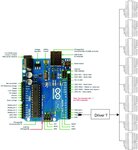Wajiduddaim
Junior Member level 1

- Joined
- May 12, 2011
- Messages
- 18
- Helped
- 0
- Reputation
- 0
- Reaction score
- 0
- Trophy points
- 1,281
- Location
- darbar-e-Sadria
- Activity points
- 1,464
i am using one arduino Uno (Atmega 328p) to send serial data
and receive that data using 89c51 microcontroller those are almost 12 microcontrollers (At the receiving end)
is it danger for Tx of atmega 328?????
if it is then how can in safe it ??? any serial Driver?
baud rate is 9600
and receive that data using 89c51 microcontroller those are almost 12 microcontrollers (At the receiving end)
is it danger for Tx of atmega 328?????
if it is then how can in safe it ??? any serial Driver?
baud rate is 9600

